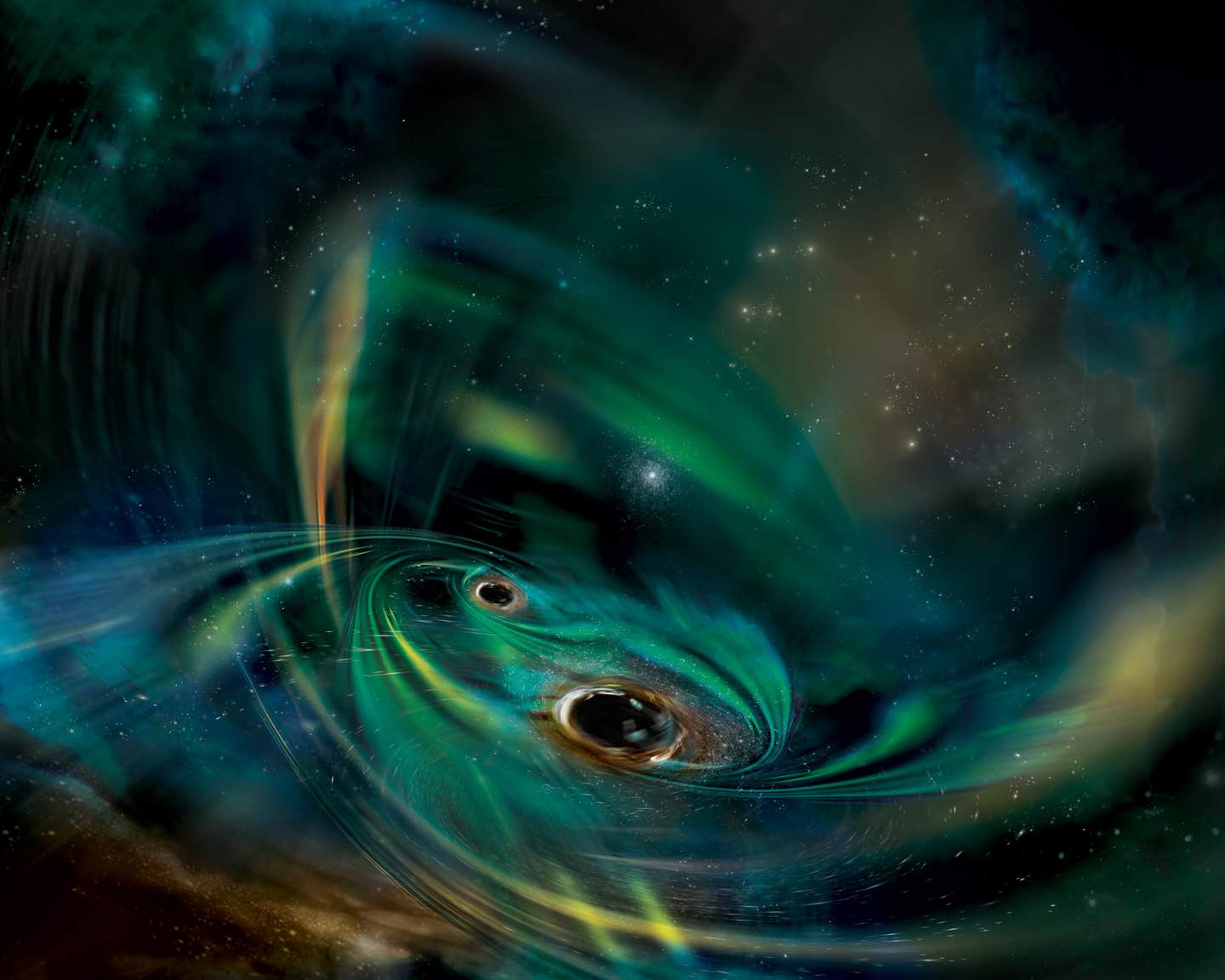Two monstrous black holes are consuming a massive gas cloud
Astronomers discover binary black holes disrupting a gas cloud, revealing oscillating light patterns in a galaxy 1 billion light-years away.

Scientists uncover a binary black hole system disrupting a massive gas cloud. (CREDIT: NASA/Aurore Simonnet (Sonoma State University))
At the heart of most galaxies lies a supermassive black hole, often surrounded by a disk of matter that feeds it. This combination, known as an active galactic nucleus, can emit powerful light, varying across the electromagnetic spectrum. These fluctuations usually follow predictable patterns, but some objects defy expectations, revealing new insights into the universe's workings.
Astronomers have recently uncovered a groundbreaking discovery involving two monstrous black holes. This event, called AT 2021hdr, has challenged conventional understanding of galactic activity. Observations suggest that these black holes are disrupting and consuming a massive gas cloud, creating an oscillating light pattern unlike anything seen before.
“This is a very unusual event,” explained Lorena Hernández-García, an astrophysicist in Chile. She and her team believe the gas cloud envelops the black holes, and as they orbit each other, the interaction disturbs the gas, causing periodic emissions of light. This discovery, detailed in the journal Astronomy and Astrophysics, is a remarkable step in understanding black hole dynamics.
AT 2021hdr occurs in a galaxy located a billion light-years away in the constellation Cygnus. The two black holes are separated by 26 billion kilometers, close enough for light to take just one day to traverse the distance. Together, their mass is 40 million times that of the Sun. Orbiting each other every 130 days, these black holes will eventually merge in about 70,000 years.
The event was first detected in March 2021 by the Zwicky Transient Facility (ZTF) at California’s Palomar Observatory. The flare was flagged as a potentially interesting source by ALeRCE, a Chilean initiative that uses artificial intelligence to identify astronomical phenomena. Initially mistaken for a supernova, subsequent outbursts in 2022 prompted researchers to reconsider. Each flare refined their understanding of what might be occurring within the system.
ZTF has consistently detected bursts from AT 2021hdr every 60 to 90 days. To gain deeper insights, Hernández-García and her team turned to NASA’s Neil Gehrels Swift Observatory. Since November 2022, Swift has tracked oscillations in ultraviolet and X-ray light, matching the patterns observed in visible light by ZTF. This multiwavelength data has been crucial in unraveling the mystery.
Related Stories
Researchers analyzed several possible explanations. At first, they considered that the variability might stem from normal galactic center activity. Then, they explored the possibility of a tidal disruption event, where a star is destroyed by a black hole’s gravity.
However, the data didn’t align with these scenarios. The most plausible explanation involved a massive gas cloud being torn apart by the black holes. As the cloud’s gas interacts with the binary system, friction heats it, creating the observed oscillations.
The process begins when the cloud encounters the black holes’ intense gravitational forces. The gas is shredded into filaments that orbit the pair, becoming denser and hotter near the black holes. With each orbit, forces within the system eject some of the gas, producing the fluctuating light patterns recorded by ZTF and Swift.
These findings shed light on how massive binary black holes interact with their surroundings. Hernández-García’s team plans to continue observing AT 2021hdr to refine their models and learn more about the system’s behavior. They’re also investigating its host galaxy, which is in the process of merging with another galaxy—a phenomenon that could influence future activity.
“With Swift’s 20th anniversary approaching, it’s incredible to see all the new science it continues to help the community achieve,” said S. Bradley Cenko, Swift’s principal investigator at NASA’s Goddard Space Flight Center. This mission, managed in collaboration with institutions across the globe, underscores the power of international cooperation in unraveling cosmic mysteries.
Astronomical facilities like Swift and ZTF exemplify the advancements in observing variable objects across the sky. Swift’s rapid response capabilities and multiwavelength coverage provide vital data for understanding dynamic cosmic phenomena. ALeRCE’s integration of artificial intelligence further highlights how technology accelerates discovery in modern astronomy.
This event is a testament to the progress in exploring the universe’s most enigmatic objects. By continuing to monitor these black holes and their interactions with their surroundings, scientists hope to uncover even more about the fundamental forces shaping galaxies.
AT 2021hdr’s peculiar light patterns may hold the key to unlocking deeper knowledge about the cosmos’ evolution and the role of supermassive black holes in it.
Note: Materials provided above by The Brighter Side of News. Content may be edited for style and length.
Like these kind of feel good stories? Get The Brighter Side of News' newsletter.
Joshua Shavit
Science & Technology Writer | AI and Robotics Reporter
Joshua Shavit is a Los Angeles-based science and technology writer with a passion for exploring the breakthroughs shaping the future. As a contributor to The Brighter Side of News, he focuses on positive and transformative advancements in AI, technology, physics, engineering, robotics and space science. Joshua is currently working towards a Bachelor of Science in Business Administration at the University of California, Berkeley. He combines his academic background with a talent for storytelling, making complex scientific discoveries engaging and accessible. His work highlights the innovators behind the ideas, bringing readers closer to the people driving progress.



